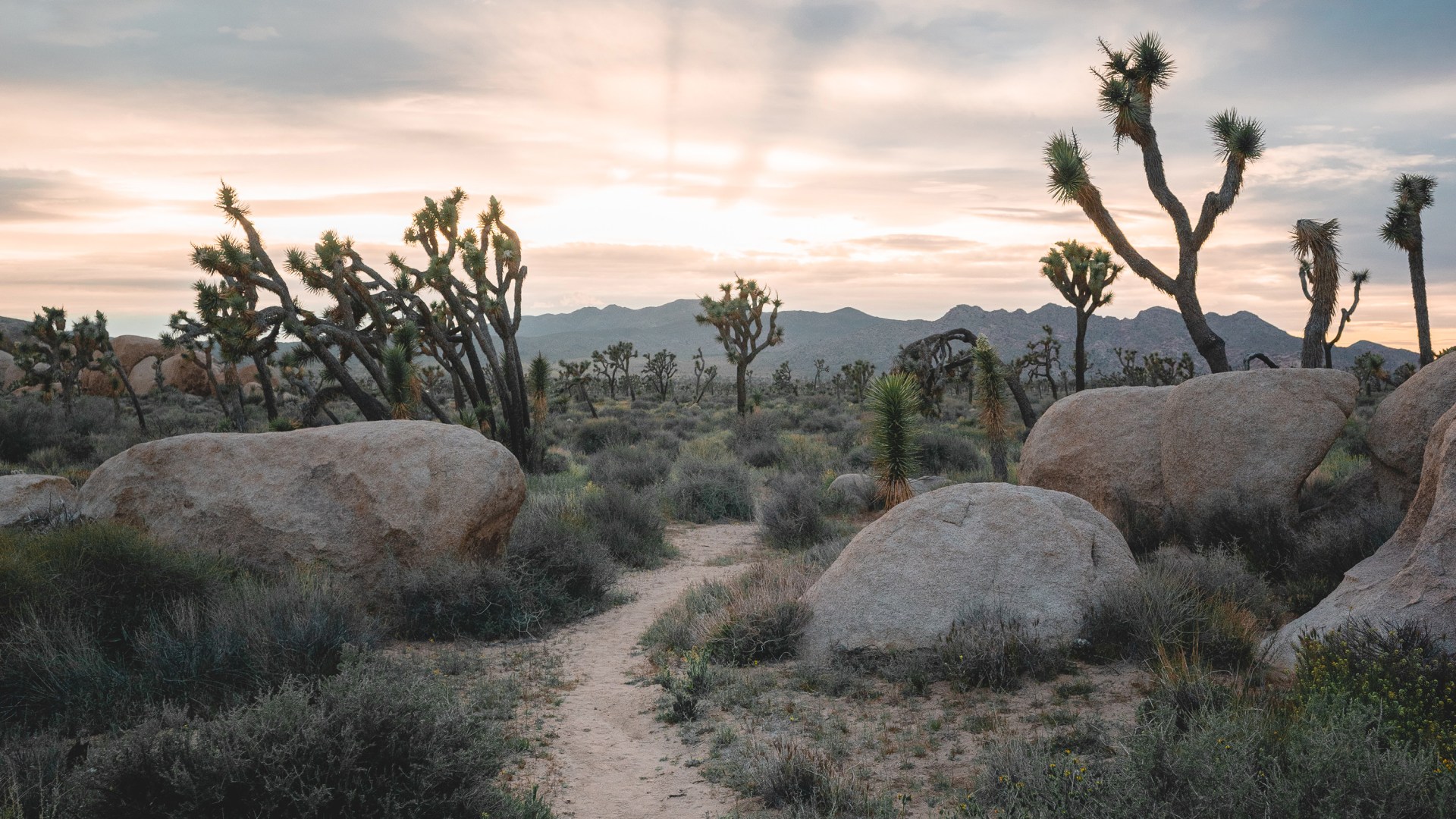Joshua Tree gives me the creeps. The landscape unnerves me—dirt, dust, cactus, and, of course, the trees themselves, scaly and spiky and twisted. They’re lined out like a crop, too intentional to make sense. How did they get here? At the top of Ryan Mountain, my husband and I study the brown land. No cell connection. No water! We keep our own jugs in the back of the car.
Boulders shaped like skulls and arches and cathedral spires interrupt the desert. These are enormous rocks, nonsensical rocks, rocks that people climb with ropes and hooks or slip in between: See the “Hall of Horrors,” a slot canyon narrower than outstretched arms. These are rocks you can tumble from, cracking bones. While the sun sets, we visit 12 square miles of granite—called the Wonderland of Rocks—and scoot among the formations.
Eventually, we lose the path. I am nervous. In the twilight, the looming boulders feel unpredictable. Who knows what they’ll transform into? But there, in the narrow inlets of sand between them, we see wildflowers, growing in lavender and periwinkle and violet. They give indications of life, of some preposterous plan—like the cactus garden that stretches out along the highway, smelling of creosote, birds building nests among the spines. Again: Who put this here? Near the Hall of Horrors, a jackrabbit bounds into the shadows.
The Joshua trees themselves march on, row after row after row. The story goes that 19th-century Mormon settlers named them for the biblical prophet because their arms look like they’re raised in supplication. Supplication. An especially deferential plea. Still urgent, though, even with its acknowledgement of limited power, limited means.
The arms jut and branch and double back on themselves, sometimes fulsome and sometimes sparse. They look uncomfortable. They’re trying everything. Trying to survive. Trying to find something to drink, far away from the oases that feed palm trees. They look how I feel here: buffeted and chapped, standing next to a tent that’s flapping and throwing up dust as we try to lash it into place.
Landscapes can agitate me like this.
On another vacation, much further west, I stood before Haleakalā, the dormant volcanic crater on Maui, and wanted only to leave. Down below, back in town, there were mai tais and banana bread. Up there? Just things as they were. Too deep, too shadowy, too dormant—and yet, still alive, cooled lava flows and cinder cones holding shifting light and fog.
“Your fear of immensity,” my husband calls it, when I start to get restive and pensive and quiet on our trips: when we’re driving at the edge of sea cliffs on California’s Highway 1 or listening to howls in the night from the spare shelter of our tent. And he’s right. I’m not afraid of heights or driving or coyotes or water, which don’t concern me in other circumstances. I’m afraid of being swallowed up whole. Decentered. Caught up in something. Seeing or hearing too much.
Right now, during Lent, I’m reading a book of sayings by the Desert Fathers and Mothers, early Christian ascetics and mystics who lived as hermits or in small monastic communities. Their home: the Scetes Desert, full of large, prehistoric fossils and lakes saturated with salt. They prayed and wrote and meditated in large expanses and difficult conditions.
The desert, of course, is the place for reckoning. Forty days of temptation for Jesus. Forty years of exile for the Israelites. They wandered in circles, seeing the same things again and again, trying not to be broken by them. They were uncertain of water, uncertain of food, trusting (and doubting) provision.
Nature is where we go for glory and peace. I think of the landscapes of my Oregon childhood, familiar as the faces of friends: Douglas fir forests, mountain lakes, overcast beaches. The river running over the silt.
But nature is also terrifying and dangerous. It can uncover us. It can even disturb. Creatures prowl and directions fail. Beauty becomes too hot to the touch, too harsh, too steep, too much, unable to be captured by a camera or even a mind. Nature certainly “puts things in perspective,” but not always in a pleasant way. God meets us there in his omnipotence—in control even of the utterly wild.
The Desert Fathers and Mothers give instructions that make sense anywhere: Don’t be prideful. Give away your money. Don’t be gluttonous. Be grateful. But to imagine them in the context of the desert, dusty and defeated, gives the words a different meaning.
Even in extremity, they’re still doing battle with the temptations of the mind and the longings of the heart, still bound by the same jealousies and complaints of any city dweller. They’re only more aware. Their whole lives were more of a Lent than mine ever will be: all penance, reckoning, and preparation, with ultimate questions always on the surface—as given as salt in the lake. How could you not think about death when it awaited you with one misstep, one stream run dry?
Somehow, they stayed among those clear, painful realities. Here, back at home, those realities are often obscured. From my vantage point, the human condition looks like comfort—electricity, cell service, running water, a souvenir mug decorated with a Joshua tree, photos on a phone—everything sized to fit my hands and designed for my convenience. It’s easy to forget the stakes.
Out there at the edges, on the plains, above the void, we see things as they really are: everything, always, an act of supplication.
Kate Lucky is senior editor of audience engagement at Christianity Today.









